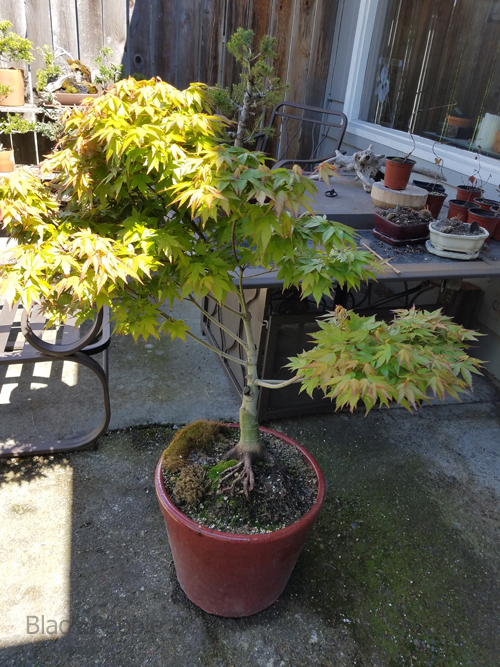
- Details
- Written by Black Pebble Bonsai
- Category: Tree Species
- Hits: 1058
Dwarf Alberta Spruce (Picea glauca 'Conica' )
This Conifer was discovered in Alberta Canada in 1904
Full or Partial sun
It's small tight foliage are great for Bonsai, and naturally a cone or Christmas tree like form. This is a 2 flush pine, meaning it grows 2 sets of needles a year.
- Details
- Written by Black Pebble Bonsai
- Category: Tree Species
- Hits: 980
ISP or Italian Stone Pine – Umbrella Pine (Pinus Pinea)

Origin:
This pine came from the Mediterranean and can be seen in classic paintings with its multi trunks and umbrella like canopy. It is a hardy grower and buds back easily.
Our Cultivation:
These trees are from cuttings, we grow them from seed, then they are cut very short and grown under controlled conditions to establish new roots which grow radially around the cut. This method which makes for short trunks, low branches and radial roots, all prized features to create your bonsai. This process is labor intensive but this is how they differ from a tree grown at a traditional nursery.
Care:
While your Italian Stone Pine is young, meaning it has not reached your desired trunk size, you should feed it an acidic fertilizer or simply Miracle Grow MirAcid in a weak solution.
Once your tree has reached the desired size, it doesn't need to be fed very often, only if it shows signs of stress.
Your Conifer is planted in a non soil mixture of Volcanic rock, Pumice and a small amount of Peat Moss, it's very difficult to overwater them unless the water is no longer draining, if it runs off the top it's time for a repotting.
Needles can be removed and branches wired, the tree will still bud branches
- Details
- Written by Black Pebble Bonsai
- Category: Tree Species
- Hits: 979
JBP or Japanese Black Pine (Pinus Thunbergii)
JBP are prized for their celebrated bonsai characteristics:
- Not difficult to style
- Beautiful bark as it ages
- Ability to back bud
- Two flush pine
Origin:
This Conifer grows on the shores of Japan with mild and wet weather, this is the traditional “Male” to the Japanese Red Pine.
Our Cultivation:
These trees are from cuttings, we grow them from seed, then they are cut very short and grown under controlled conditions to establish new roots which grow radially around the cut. This method which makes for short trunks, low branches and radial roots, all prized features to create your bonsai. This process is labor intensive but this is how they differ from a tree grown at a traditional nursery.
Care:
While your JBP is young, meaning it has not reached your desired trunk size, you should feed it an acidic fertilizer or simply Miracle Grow MirAcid in a weak solution.
Once your tree has reached the desired size, it doesn't need to be fed very often, only if it shows signs of stress.
Your Conifer is planted in a non soil mixture of Volcanic rock, Pumice and a small amount of Peat Moss, it's very difficult to overwater them unless the water is no longer draining, if it runs off the top it's time for a repotting.
- Details
- Written by Black Pebble Bonsai
- Category: Tree Species
- Hits: 979
JRP or Japanese Red Pine (Pinus Densiflora)
JRP are prized for their celebrated bonsai characteristics:
- Not difficult to style
- Beautiful red bark as it ages
- Ability to back bud
- Two flush pine
Origin:
This Conifer grows in the mountains of Japan, so they are much more cold hardy than the JBP. The thin and long needles make this the traditional “Female” to the JBP.
Our Cultivation:
These trees are from cuttings, we grow them from seed, then they are cut very short and grown under controlled conditions to establish new roots which grow radially around the cut. This method which makes for short trunks, low branches and radial roots, all prized features to create your bonsai. This process is labor intensive but this is how they differ from a tree grown at a traditional nursery.
Care:
While your JRP is young, meaning it has not reached your desired trunk size, you should feed it an acidic fertilizer or simply Miracle Grow MirAcid in a weak solution.
Once your tree has reached the desired size, it doesn't need to be fed very often, only if it shows signs of stress.
Your Conifer is planted in a non soil mixture of Volcanic rock, Pumice and a small amount of Peat Moss, it's very difficult to overwater them unless the water is no longer draining, if it runs off the top it's time for a repotting.